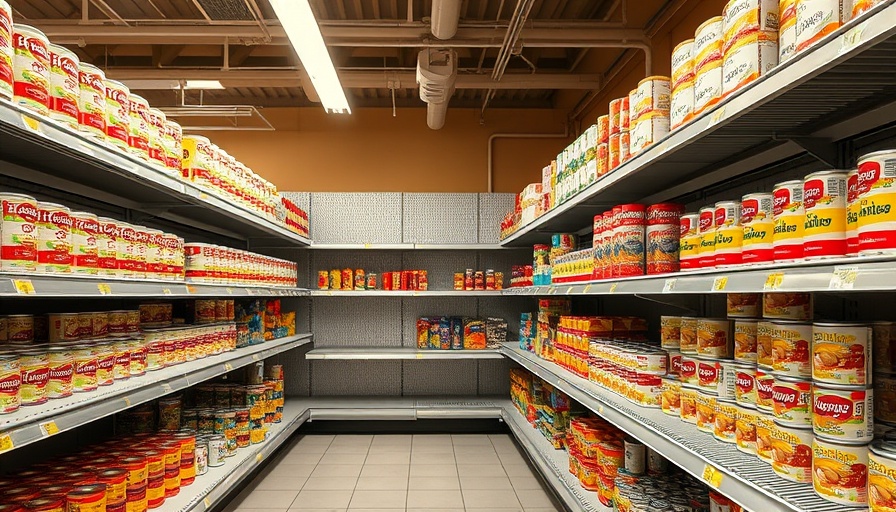
The Ongoing Grocery Store Drought: Why We Still Face Empty Shelves
The COVID-19 pandemic sent shockwaves through various sectors of the economy, and grocery stores were no exception. As the stay-at-home orders took effect in March 2020, America witnessed a historic scramble at grocery stores as consumers stockpiled essentials. Now, five years later, the haunting echo of empty shelves persists. Many shoppers, especially those between the ages of 25-55, are left asking: Why are grocery stores still out of items?
Understanding the Supply Chain Breakdown
The pandemic highlighted vulnerabilities within the food supply chain that many were unaware of. Shortages in critical components like labor due to health concerns and transportation issues have severely hindered the industry's ability to bounce back. Sources indicate that while some producers are ramping up their output, the interruptions in logistics continually affect availability.
For younger shoppers, who are more health-conscious and often aware of the environmental impact of their choices, these supply challenges add another layer of stress. They desire fresh, organic products but are frequently met with empty shelves. It is crucial to ponder how these disruptions impact their daily lives and dietary habits.
Impact of Reduced Variety in Offerings
Have you noticed a trend where your favorite chains only offer core menu items? This shift isn’t isolated to restaurants; grocery stores too are focusing on fewer, more popular products. In a bid to streamline operations, leading brands are cutting back on the variety they used to offer, resulting in voids in more niche items that health-conscious, urban consumers would typically seek.
This narrowed focus may simplify inventory management but leaves many beloved products off the shelves. It’s essential for shoppers to adapt and discover alternative brands or even consider making some products from scratch. This is where DIY enthusiasts can shine by exploring recipes at home!
Rising Prices: Inflation and New Norms
Prices have taken a steep ascent across the board, affecting all demographics. Urban consumers, especially, have seen skyrocketing prices when dining out, which adds to the growing frustration felt by families budgeting their grocery expenditures. Coupled with the shrinkage in packaging—a phenomenon that many are calling "shrinkflation"—consumers are getting less for more money.
Now, health-conscious buyers must become more adept at reading labels and comparing prices. Understanding what you get for your money is just as crucial as the ingredients themselves.
Future Predictions: Sustainability and Local Sourcing
Sustainable practices in grocery shops are more vital than ever. As food systems adapt, there's a growing push for local production that lessens reliance on heavy transportation. For the daily shopper, this means seeking out what’s available at farmer’s markets and local grocers, fostering community ties through food sources.
As we look ahead, it’s probable that more consumers will delve into growing their own vegetables or creating home gardens. The resurgence of interest in urban gardening points to a collective realization: self-sufficiency might not just be a trend but a necessary adjustment to shortages.
Empowering Community Through Gardening
For those of us affected by the food scarcity, engaging in urban gardening is an empowering initiative. This move not only mitigates reliance on grocery stores but also contributes positively to mental health and community connection. Gardening can become a catalyst for change, enabling individuals to cultivate their green thumb while enjoying the benefits of fresh, homegrown produce.
This journey into self-sufficiency can inspire a ripple effect, encouraging your neighbors to join in cultivating their gardens. Imagine the bond that forms through shared experiences, trading tips, and even produce harvested from each other's gardens!
Act Now: Embrace Urban Gardening for Your Family
Understanding how to sustain your family amidst ongoing grocery shortages is essential. Consider starting your urban garden today! It's a rewarding endeavor that allows you to take control of your food sources while engaging in sustainable practices. Together, let’s cultivate a community that thrives on independent food systems.
Join local gardening initiatives or workshops in your area to meet fellow DIY enthusiasts who share your passions for eco-living!
 Add Row
Add Row  Add
Add 




 Add Row
Add Row  Add
Add 

Write A Comment